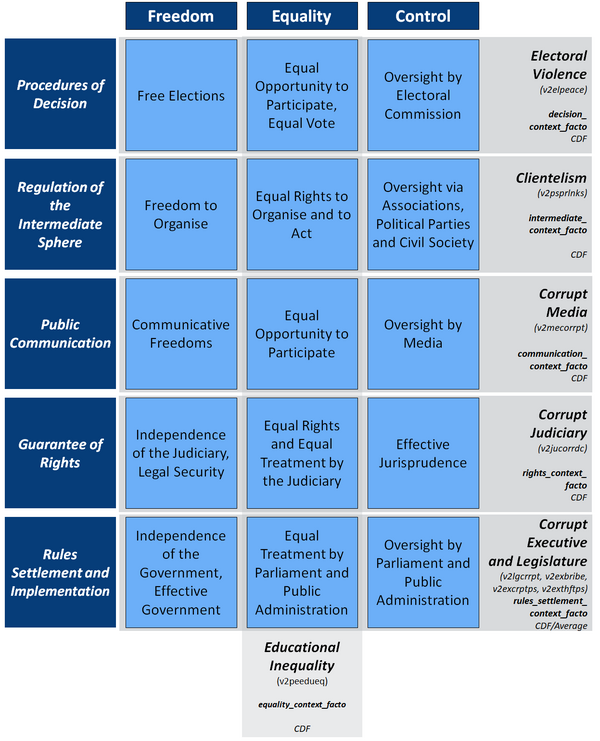As second level of measurement of the democracy matrix, context measurement is based on core measurement and involves other relevant factors, which influence the democracy quality of a country and permit the measurement of overall democracy quality to be more “realistic”. In contrast to the endogenous properties of core measurement, the factors taken up here are not conceived as characteristics of democracy itself, but rather concern the exogenous embedding of the political system: How is democracy quality distorted by external factors? Three groups of exogenous factors in the sense of necessary conditions are adduced, all of which remain within the limits of a middle-range definition of democracy, since only their impact on democracy quality is examined (e.g. social inequality produces political inequality): educational inequality, informal institutions and statehood. These factors are presented on this website using the indicators selected from the V-Dem dataset for the purpose of operationalisation. The aggregation rules are described here.
1. Adjusted Calculation of Core Measurement Taking Context Factors into Account
Context measurement arises from combining context factors with core measurement. The scale of the individual context factors is restricted to 0.75 to 1, whereby a lower value represents high disruption by context elements and high value represents limited disruption by the context. From the point of view of democracy theory, a multiplication procedure on the result of the core measurement is justified, due to the status of the influencing factors as necessary conditions. By way of the multiplication procedure, these factors can never increase democracy quality, but can only change it for the worse. The most negative impact of context factors (0.75) is assessed as so serious that a country with a maximum core measurement value (1) is situated in the deficient democracy range. If no negative context factors are present, the result of the core measurement is, finally, confirmed.
2. Impact of Educational Inequality
Education can be seen as necessary condition for the functioning of a democracy. Education – above all, political education – assures that democratic rights, procedures and institutions are known to citizens. Without political competence and knowledge, citizens cannot make use of them (Lauth 2004; Lauth/Schlenkrich 2018).
Education enters into the democracy matrix as educational inequality and thus affects the entire dimension of equality. Educational inequality cannot be attributed to an individual institution, but rather equally affects the democracy quality of all institutions. Citizens without political knowledge and competencies have a harder time formulating their interests (procedures of decision, regulation of the intermediate sphere, public communication) and claiming their rights (guarantee of rights, and rules settlement and implementation) in all areas of democracy.
3. Impact of Informal Institutions
In addition, democracy-encumbering informal institutions such as clientelism, corruption and the threat of violence have to be included in democracy measurement, since – just like formal institutions – they influence the behaviour of actors. Since they influence the functioning of a democracy negatively in the sense of a necessary condition, their impact cannot be ignored (Lauth 2000, Helmke/Levitsky 2004). Moreover, informal institutions have a multi-dimensional impact: harm done to just one single democracy dimension or democracy institution due to the presence of informal institutions cannot be reasonably assumed. They can be conceived rather as “broadband indicators” for the condition of a democracy. For example, corruption undermines the functioning of a democracy in a variety of ways. On the input side, the decision-making process is perverted, inasmuch as decision-makers are manipulated. On the output side, the implementation of democratically made decisions is undermined and highly distorted. V-Dem offers institution-specific corruption indicators, which we take up.
V-Dem indicators used: v2elpeace, v2psprlnks, v2mecorrpt, v2jucorrdc, v2lgcrrpt, v2exbribe, v2excrptps, v2exthftps
Aggregation rules applied: CDF, average
4. Impact of Statehood
Understood in the tradition of Max Weber as legitimate monopoly on the use of force, statehood is also an elementary condition for democracy quality (Bäck/Hadenius 2008, Schlenkrich et al. 2016). A falling degree of statehood brings about a reduction in the quality of any regime, whether it is autocratic or democratic. Since many studies have indicated that statehood is not always fully present in new democracies, this aspect should be taken into consideration in democracy measurement, in order to arrive at appropriate results.
This aspect should be taken into account in later versions of the democracy matrix. For the moment, however, the V-Dem indicators are not offered due to data errors.
5. References
Bäck, Hanna and Axel Hadenius. 2008. Democracy and State Capacity: Exploring a J-Shaped Relationship. In: Governance: An International Journal of Policy, Administration, and Institutions 21, pp. 1–24.
Helmke, Gretchen and Steven Levitsky. 2004. Informal Institutions and Comparative Politics: A Research Agenda. In: Perspectives on Politics 2, pp. 725-740.
Lauth, Hans-Joachim. 2000. Informal Institutions and Democracy. In: Democratization 7, pp. 21-50.
Lauth, Hans-Joachim. 2004. Demokratie und Demokratiemessung. Wiesbaden.
Schlenkrich, Oliver, Lukas Lemm and Christoph Mohamad-Klotzbach. 2016. The contextualized index of statehood (CIS): assessing the interaction between contextual challenges and the organizational capacities of states. In: ZfVP 10, pp. 241-272.


